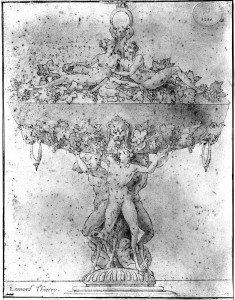London, Victoria and Albert Museum, no. 2286.
Pen and ink and wash, 26 x 20.7. The design has been traced with a stylus. Inscribed in ink in the lower left corner: Leonard Thierry, and below this name, also in ink: 293, with a pen line through it.
PROVENANCE: Sir Thomas Lawrence (Lugt 2445).
LITERATURE:
Carroll, 1964 (1976), I, Bk. I, 253, II, Bk. II, 412-415, D. 48 (COPY), Bk. III, Fig. 127, as a copy done before 1543 of a lost drawing by Rosso of ca. 1533-1538, and in the “Preface” of 1976, vii, as questionable that it is after Rosso.
Béguin, RdA, 1969, 105, Fig. 12, as by Thiry and showing the same design as an etching by Fantuzzi (Zerner, 1969, A.F. 54b).
Berckenhagen, 1970, 11, under no. 6560.
Brugerolles and Guillet, 1994, 104, 106, n. 9, under no. 36, as Thiry.
The drawing is related to an etching of 1543 by Fantuzzi (Fig.RD.22, Etching) in the same direction. But they are not identical. The design of the ring at the top of the cover is slightly different and the putto holding it is bald in the print. In the print the bunches of grapes on the lid hang over its rim. The satyr below at the left in the etching has breasts but not in the drawing. At the bottom left the putto is bald in the drawing, and the putto at the right has no visible head. Furthermore, the designs of the bases are different. Thus the drawing was not the direct model for the print, and the stylus marks on the drawing may have been made when it was traced from another drawing.
It is clear that the penmanship of the Covered Cup is too feathery to be Rosso’s, and the washes too indecisively placed to be his. The draughtsmanship seems to be the same as that of the copy of Rosso’s Education of Achilles (Fig.D.53). It is likely that the draughtsman is Leonard Thiry, whose name is inscribed (by Padre Resta?) on the sheet; the same inscription in the same hand appears on the copy of Rosso’s Allegory of Deceit (Fig.D.56).1
In 1964 I argued that the drawing is a copy of a lost drawing by Rosso but this is not an opinion I hold now. The figural vocabulary reflects his in France, but it lacks the stylistic sharpness in the poses and the expressive passion of his figures. The use of the grapevine appears too naturalistic for him, and lacks in its description the wit of Rosso’s decoration. It is surprising that there is no strapwork on the object, as there is in the Design for a Candlestick that seems very likely to be his invention (Fig.D.49). One might well wonder if Rosso would have left the top of the cup above the grapevine so completely unornamented. It seems to be most probable that the Design for a Covered Cup is Thiry’s invention, and also drawn by him, as the old inscription indicates. The design seems to have existed in another version to which Fantuzzi’s etching would probably have been more closely related, as also the drawing in Berlin (see below).
OTHER VERSION: Berlin, Kunstbibliothek, no. 6560 (Fig.RD.22, Copy). Pen and brown ink and brown wash, 30.9 x 24.6, sheet somewhat soiled. Inscribed in ink at the lower right: PL (combined as a monogram), and at the lower left: Peter Lastmann (geb. zu Harlem 1562) Schuler Rembrandt’s. PROVENANCE: Adalbert von Lanna, Prague (Lugt 2773, on the verso). Professor Michelis, Weimar (note in pencil on the verso). Marc Rosenberg. LITERATURE: Berckenhagen, 1970, 10-11, no. 6560, under Rosso, as a copy of Fantuzzi’s etching.
Details of the drawing – the design of the base, for example – indicate that the drawing was not copied from Fantuzzi’s etching. It was also not copied from the drawing in London; the satyr at the left has breasts, and the putto at the lower right has a visible head. Thus the drawing would seem to go back to the drawing from which the London drawing is also derived.

